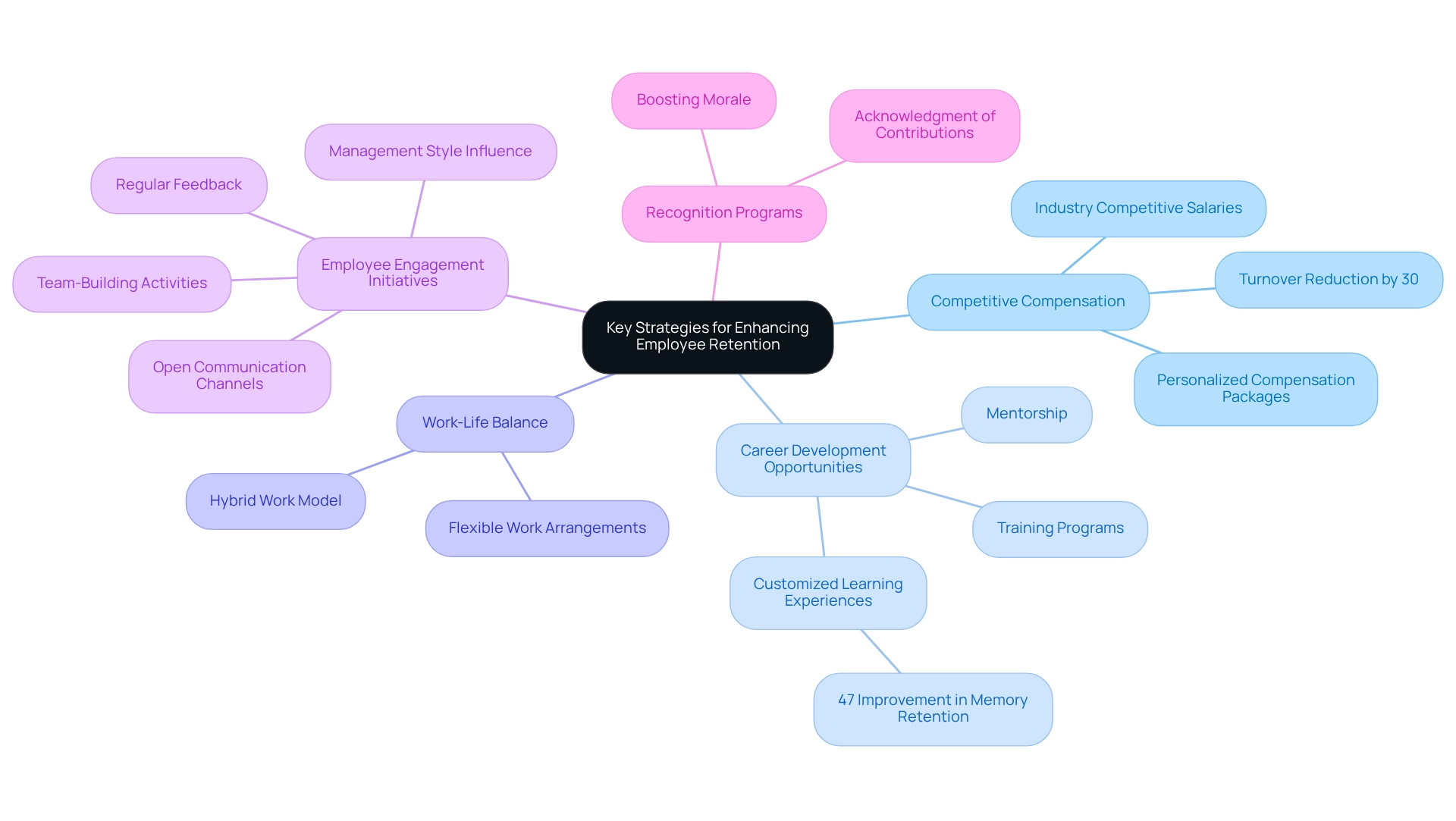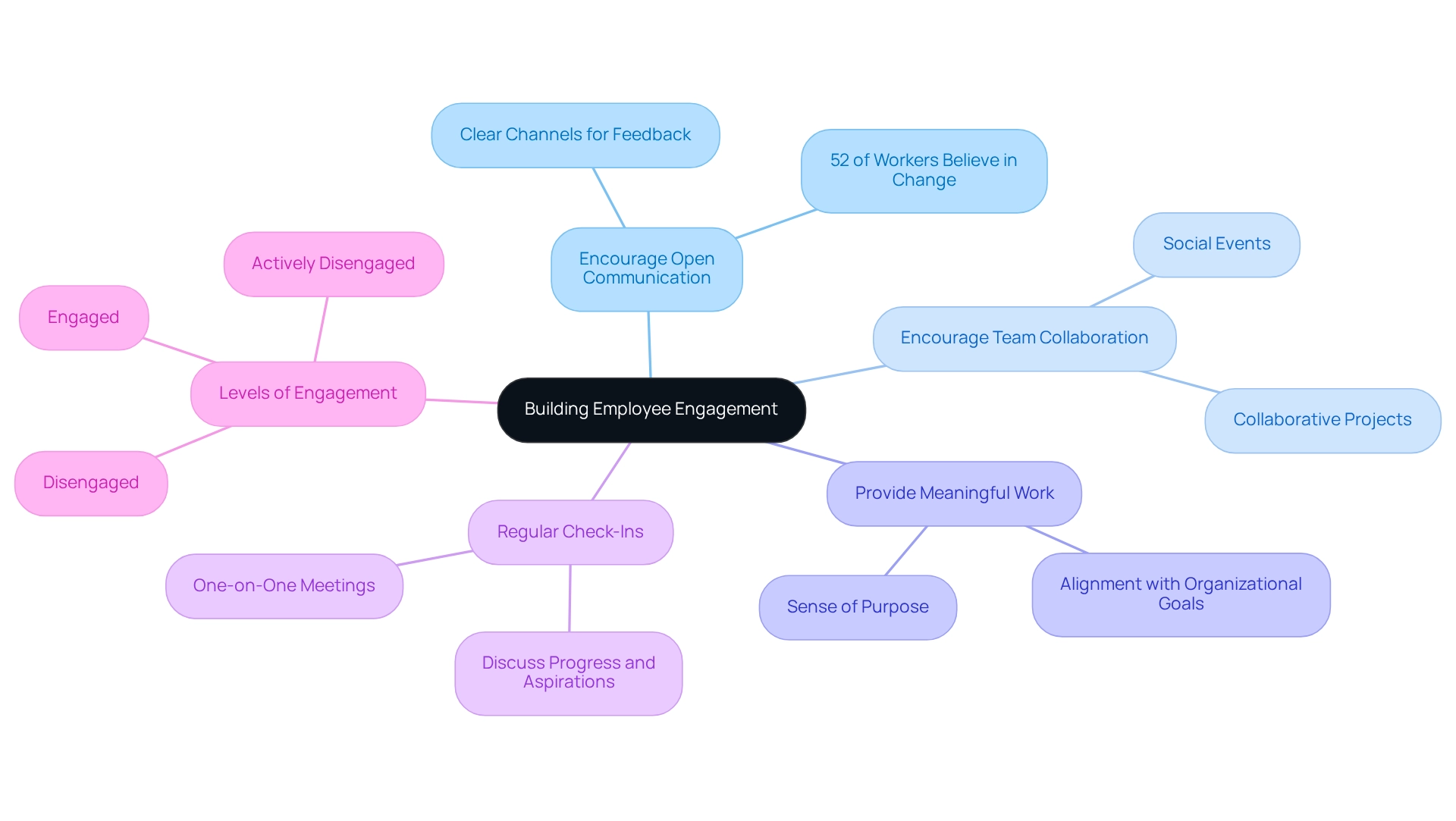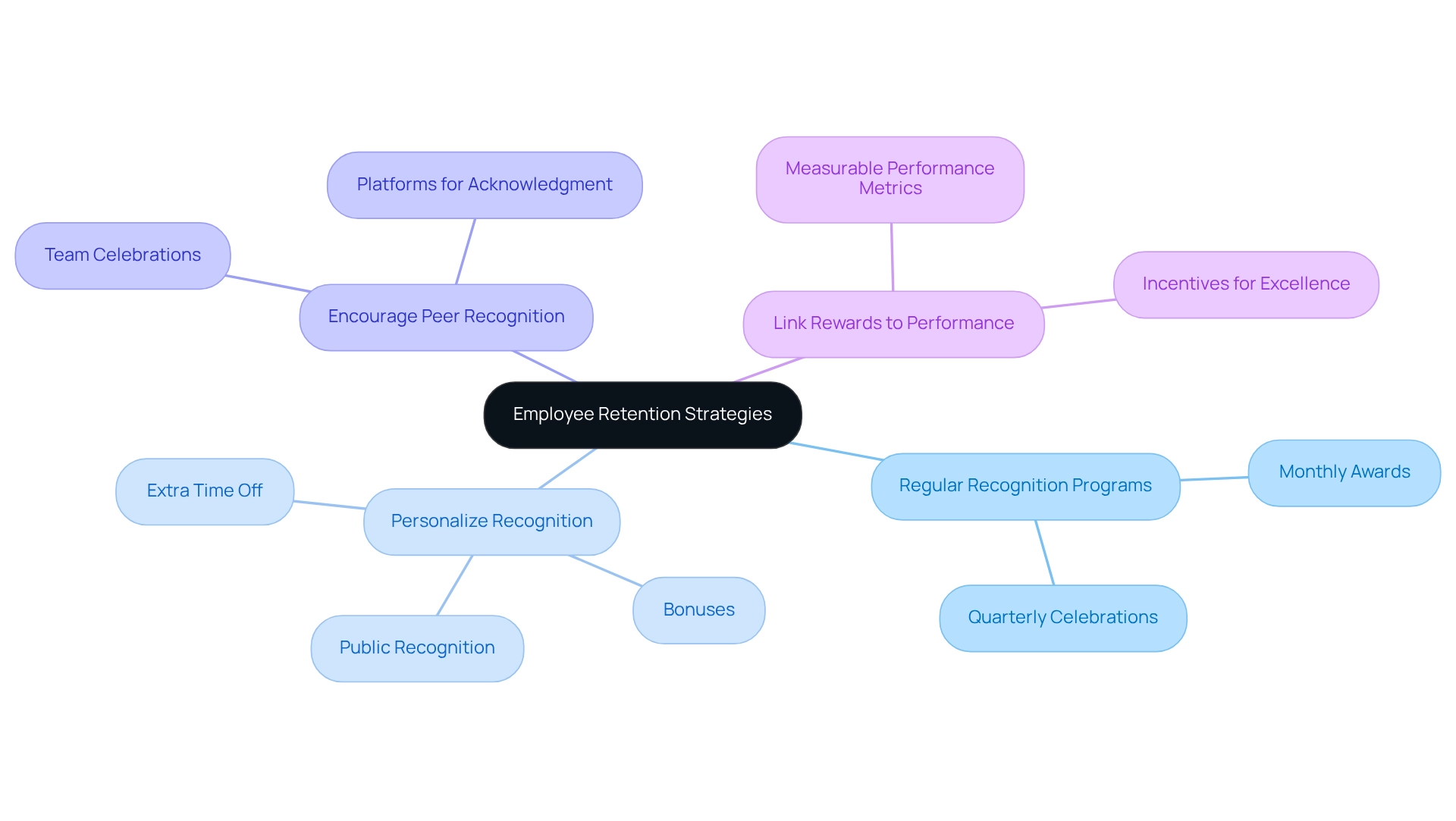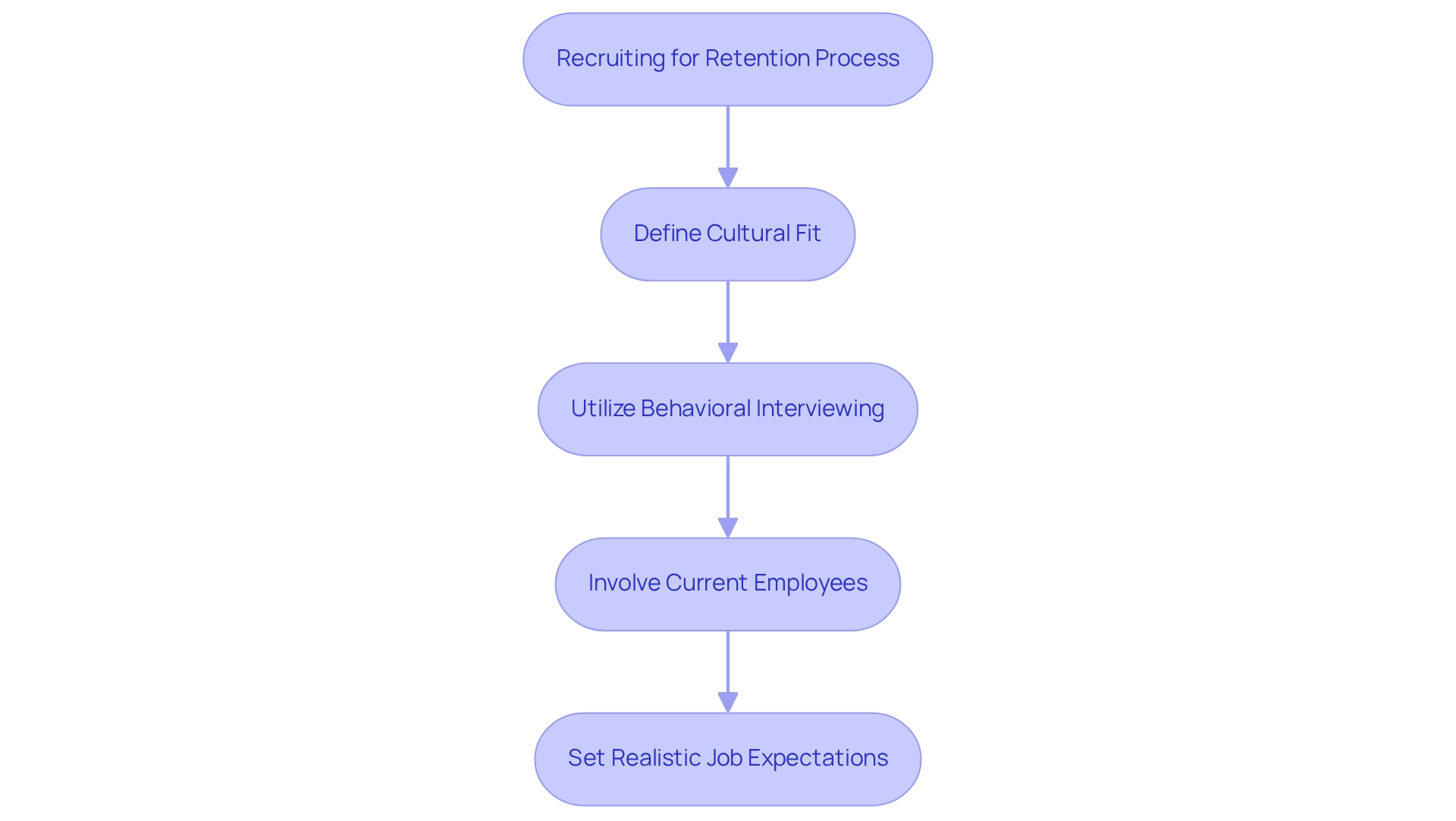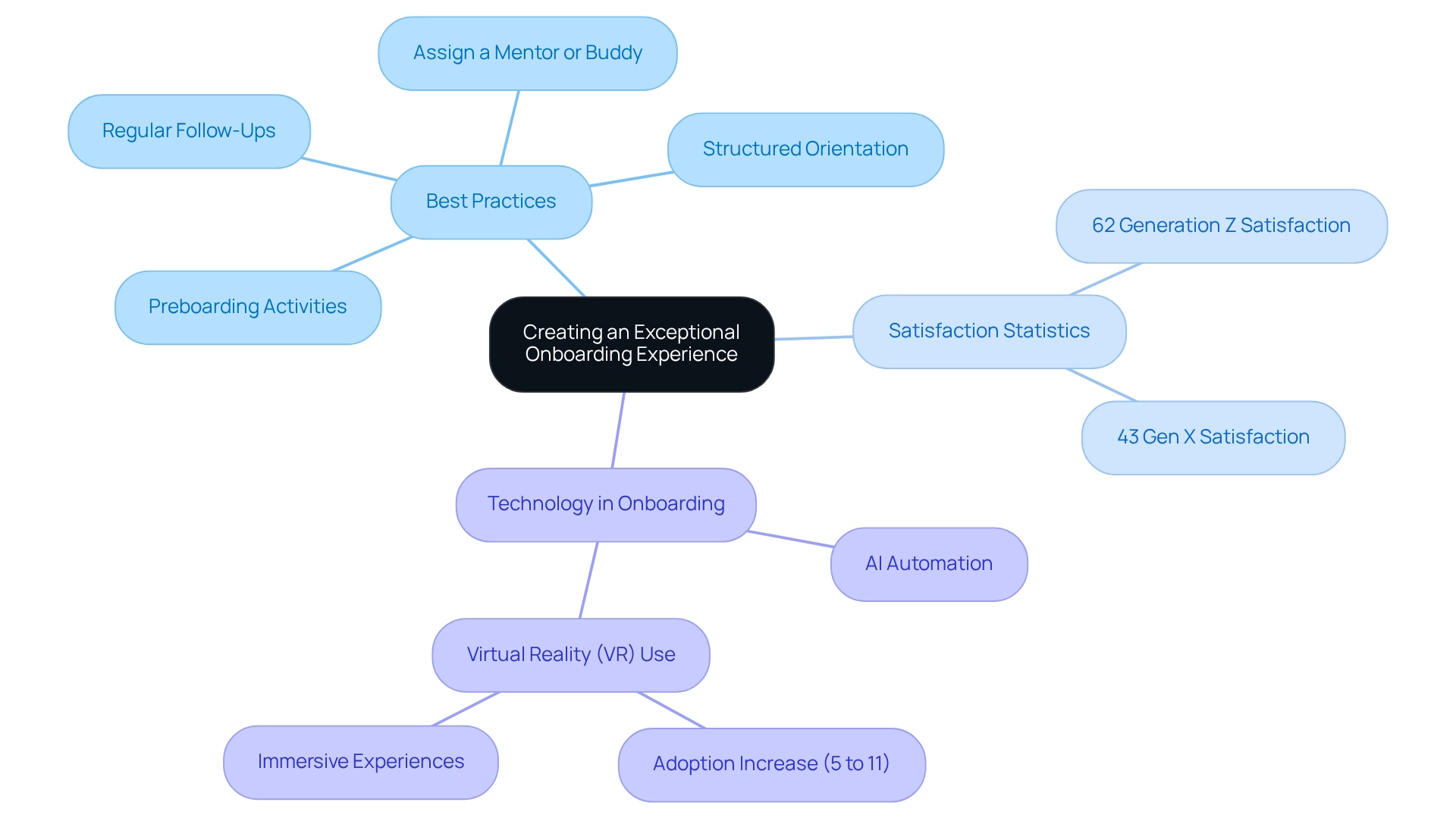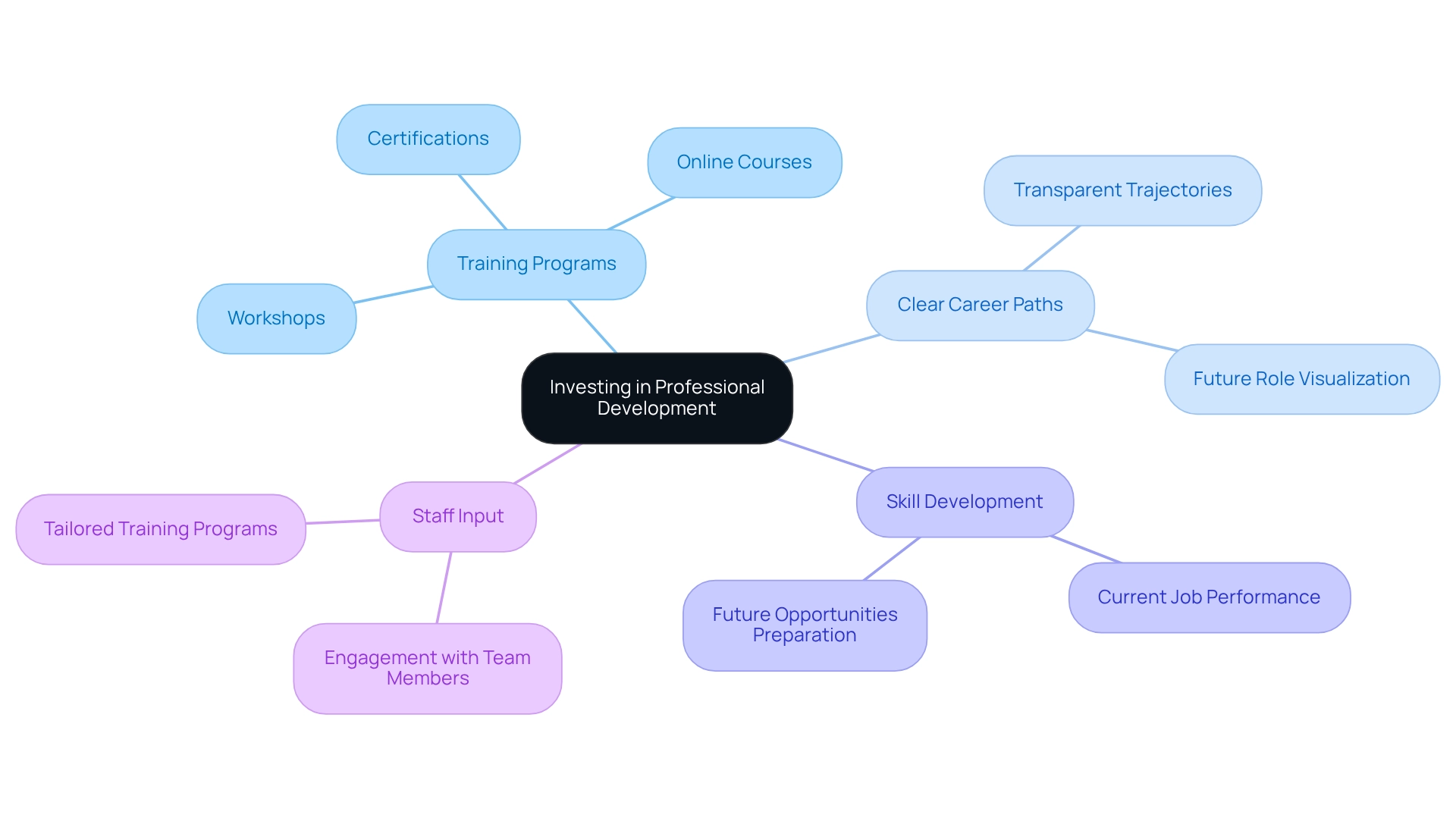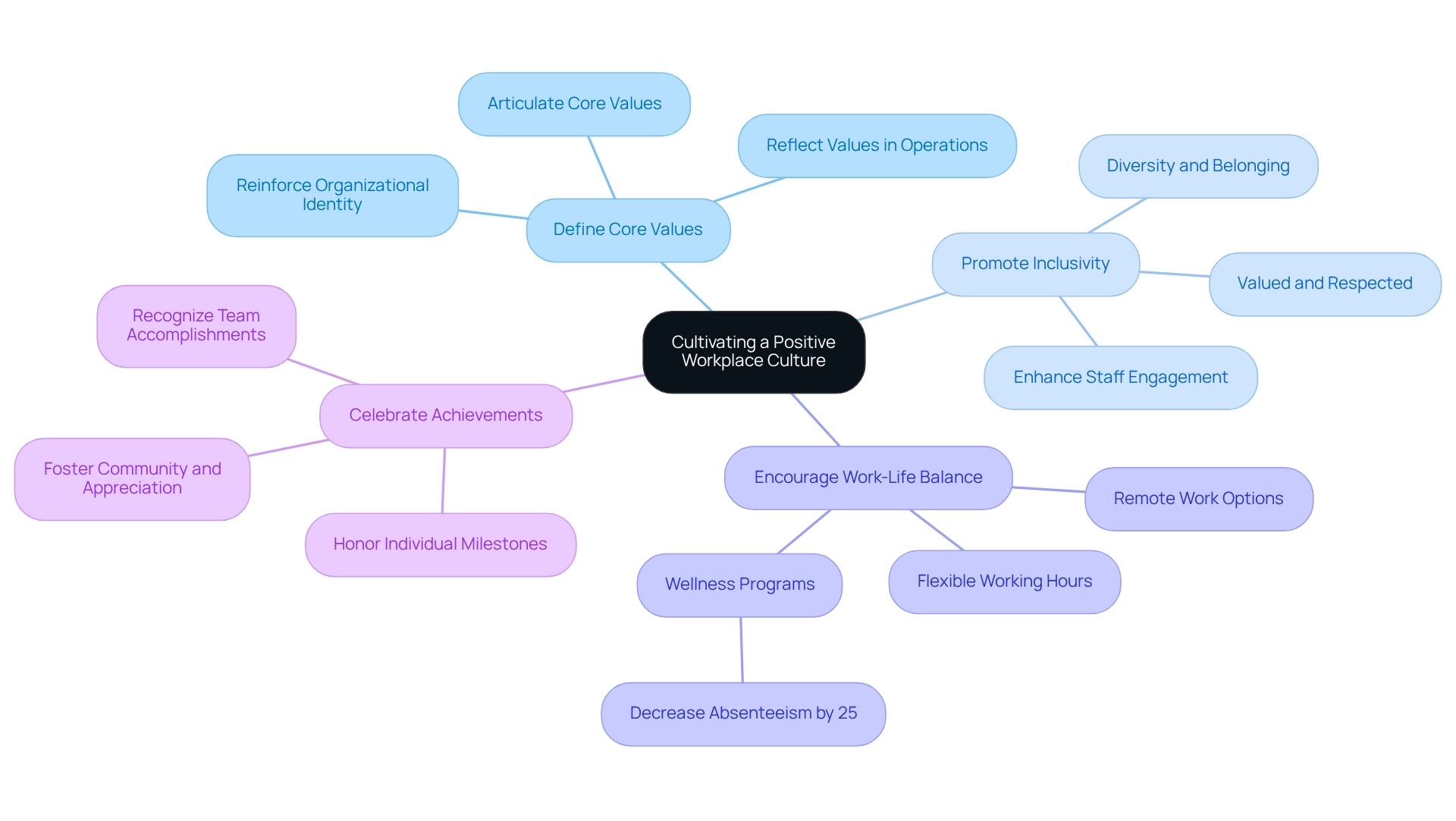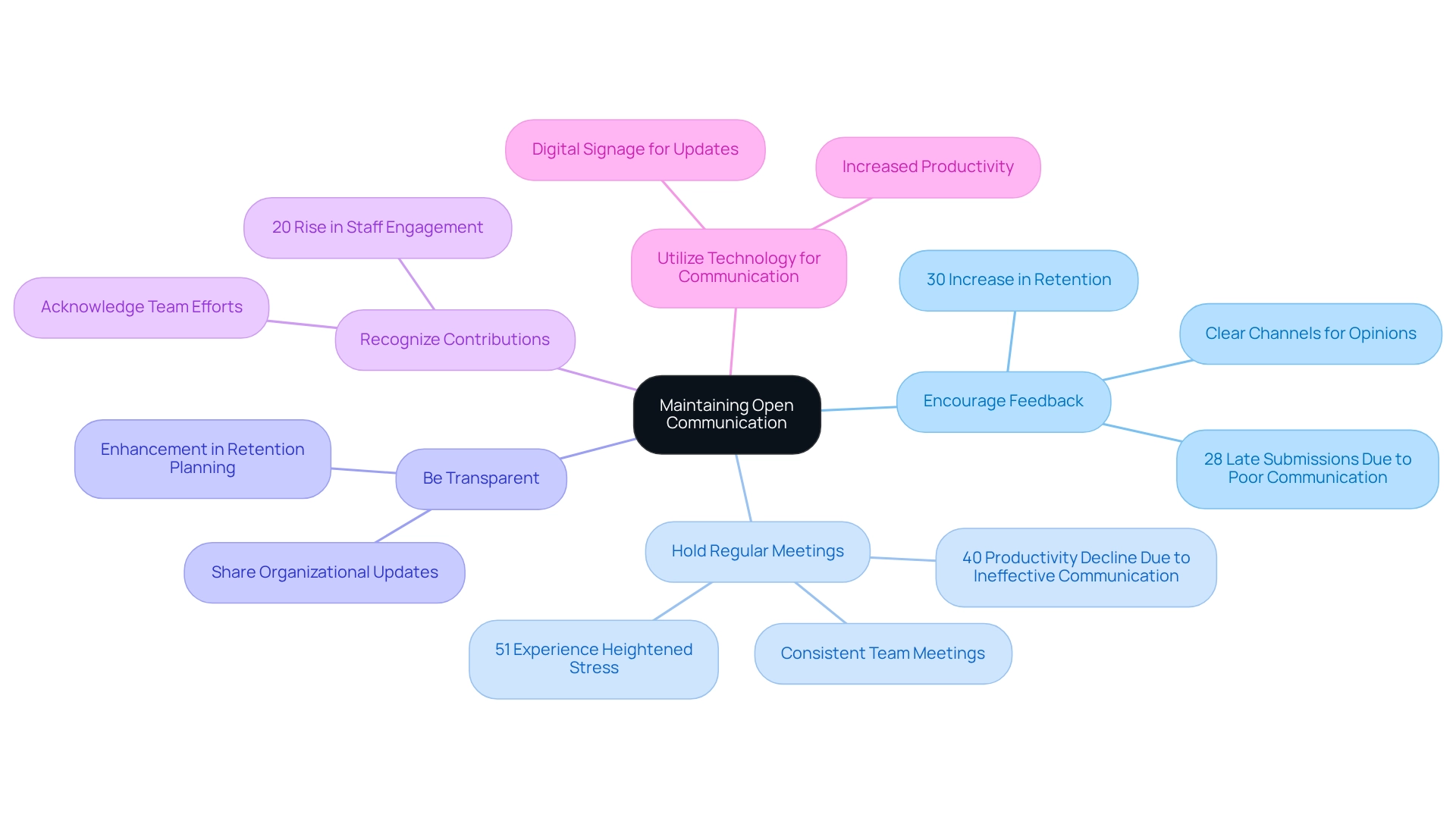Overview
An effective employee retention planning strategy is crucial for organizations aiming to thrive in today’s competitive landscape. Implementing:
- Competitive compensation
- Flexible work arrangements
- Opportunities for career development
- Fostering a positive workplace culture
can significantly enhance employee loyalty. Evidence shows that organizations prioritizing these elements not only reduce turnover but also improve morale and productivity. This is not merely a suggestion; it is a strategic necessity for any organization that values its workforce.
Key Highlights:
- Employee loyalty is crucial for maintaining a stable workforce, especially in a competitive job market in 2025.
- High loyalty rates indicate a positive work environment, while low rates may suggest management issues or lack of growth opportunities.
- Organizations that focus on employee retention can reduce recruitment and training costs and enhance productivity and morale.
- 47.2% of organizations in key sectors like Transportation, Healthcare, and Manufacturing struggle with employee retention.
- Flexible work hours and remote work options are significant factors influencing employee retention, with 54% of employees considering job switches for these benefits.
- Competitive compensation packages can reduce turnover by as much as 30%, emphasizing the need for industry-aligned pay.
- Career development opportunities, including training and mentorship, foster loyalty and engagement among employees.
- Open communication and regular feedback are vital for nurturing staff engagement and reducing turnover.
- Recognition and rewards significantly enhance employee loyalty and satisfaction, with acknowledged employees being happier and more productive.
- Recruiting for cultural fit helps organizations retain employees who align with their values, reducing turnover rates.
- A positive workplace culture, defined by core values and inclusivity, is essential for retaining talent.
Introduction
In the ever-evolving landscape of the modern workplace, employee retention stands as a pivotal concern for organizations striving to maintain a competitive edge. As companies grapple with a tightening labor market and shifting workforce expectations, the imperative to attract and retain talent has reached unprecedented levels. High retention rates not only signal a healthy work environment but also translate into significant cost savings and enhanced productivity.
This article delves into the multifaceted nature of employee retention, exploring its importance, the challenges faced across various sectors, and effective strategies that organizations can implement to foster loyalty and engagement among their workforce. From cultivating a positive workplace culture to leveraging flexible work arrangements, the insights presented here aim to equip companies with the necessary tools to thrive in this dynamic employment landscape.
Understanding Employee Retention: Importance and Impact
Employee loyalty is a critical metric for organizations, reflecting their ability to maintain a stable workforce over time. In 2025, the significance of employee loyalty has never been more pronounced, as companies face a competitive job market where attracting and keeping talent is paramount. High employee loyalty rates are often indicative of a positive work environment, while low rates can reveal deeper issues such as ineffective management or insufficient growth opportunities.
Significantly, Baby Boomers have faced the sharpest drop in preservation scores, emphasizing the diverse challenges among various demographics.
The implications of keeping employees extend far beyond mere numbers. Organizations that prioritize employee retention planning can significantly reduce recruitment and training costs, which can be substantial in today’s economy. Moreover, fostering a culture of loyalty and engagement leads to enhanced productivity and morale.
Employees who feel appreciated and supported are more likely to contribute positively to their teams and the entire entity.
Statistics indicate that in 2025, the U.S. encounters challenges with employee stability, particularly in vital sectors such as Transportation & Logistics, Healthcare, Manufacturing, and Mining & Metals, where 47.2% of organizations report struggles in attracting and keeping workers. This highlights the need for effective memory strategies. Furthermore, the Chemicals industry has one of the lowest turnover rates at 9.1%, offering a comparative view on employee challenges across different sectors.
Case studies demonstrate the efficacy of different strategies for keeping staff. For instance, a significant percentage of employees—54%—indicate they would consider switching jobs for flexible work hours, while 72% report reduced stress when working from home. This data suggests that employee retention planning, which includes offering remote work options, can be a pivotal strategy for retaining top talent, aligning with employees’ desires for a better work-life balance.
The case study titled ‘Remote Work and Employee Loyalty’ emphasizes this point, showing that remote work can significantly enhance loyalty rates.
Expert opinions further emphasize the influence of employee loyalty on company culture. High retention rates contribute to a cohesive and collaborative work environment, fostering relationships built on trust and shared experiences. As observed by HR specialists, organizations that allow staff to blend their professional and personal lives are more likely to retain top talent.
In fact, as Gallup states, “If you don’t want your top talent quitting their job to go enjoy their life, you need to find a way to let them do both.”
Ultimately, employee retention planning is crucial for keeping skilled staff, which helps preserve institutional knowledge that is vital for maintaining a competitive advantage in the market. Organizations that invest in their workforce and foster an atmosphere where staff feel appreciated and involved will not only improve their loyalty rates but also nurture a flourishing organizational culture.
Key Strategies for Enhancing Employee Retention
To enhance staff loyalty, companies must implement a range of essential strategies that are indispensable in today’s competitive landscape.
- Competitive Compensation: It is vital to offer salaries and benefits that are competitive within the industry to attract and retain top talent. In 2025, trends indicate that organizations prioritizing competitive pay will see a direct correlation with improved staff loyalty rates. Research reveals that personalized compensation packages can significantly enhance retention, with statistics showing that competitive pay can reduce turnover by as much as 30%.
- Career Development Opportunities: Providing avenues for professional growth is crucial. This encompasses training programs, mentorship, and clearly defined career paths. Companies that invest in career development not only enhance staff skills but also cultivate loyalty. Research indicates that customized learning experiences can improve memory retention by 47%, underscoring the importance of personalized development initiatives.
- Work-Life Balance: Implementing flexible work arrangements is essential for supporting individuals’ personal and professional lives. The hybrid work model has emerged as a pivotal factor in fostering work-life balance, which is increasingly critical for employee retention strategies. Organizations that adopt flexibility often report higher worker satisfaction and lower turnover rates.
- Employee Engagement Initiatives: Fostering a culture of engagement is paramount. Regular feedback, team-building activities, and open communication channels can significantly enhance responsiveness and morale among staff. The management style plays a crucial role in influencing staff responsiveness and engagement levels, making it imperative for leaders to adopt an inclusive and supportive approach. Engaged employees are more likely to remain with their companies, as engagement is directly linked to profitability, enhanced morale, and reduced turnover.
- Recognition Programs: Establishing initiatives that acknowledge and reward employees for their contributions can greatly enhance their sense of value within the organization. Recognition not only boosts morale but also reinforces a culture of appreciation, which is vital for talent retention.
As highlighted in the case study ‘Retention as a Business Imperative,’ while overall turnover rates are declining, certain industries and demographics face heightened risks. By implementing these strategies focused on employee retention planning, companies can cultivate a committed workforce that is not only skilled but also aligned with the firm’s goals and values, ultimately paving the way for sustained success.
Building Employee Engagement: The Foundation of Retention
Staff involvement plays a crucial role in talent retention. Engaged personnel exhibit greater productivity, commitment, and loyalty to their companies. To nurture a culture of involvement, consider the following strategies:
-
Encourage Open Communication: Establish clear channels for staff to express their opinions and provide feedback. This approach not only ensures that staff feel acknowledged and appreciated but also strengthens their connection to the organization. Research indicates that 52% of workers believe that meaningful change can stem from such surveys, highlighting the potential impact of open dialogue on engagement and retention.
-
Encourage Team Collaboration: Facilitate teamwork through collaborative projects and social events. These initiatives enhance interpersonal connections among staff, cultivating a sense of community and belonging within the workplace.
-
Provide Meaningful Work: Assist individuals in grasping how their roles contribute to the broader organizational goals. This clarity improves their sense of purpose and aligns their personal achievements with the success of the organization, which is vital for sustaining high levels of engagement.
-
Regular Check-Ins: Managers should prioritize regular one-on-one meetings to discuss team members’ progress, challenges, and career aspirations. These interactions reinforce the worth of each staff member, making them feel valued and essential to the team’s success.
Understanding staff engagement is crucial, as it can be classified into three levels: engaged, disengaged, and actively disengaged. Involved individuals are more likely to align their personal goals with organizational objectives, contributing positively to business outcomes. In contrast, disengaged and actively disengaged individuals may hinder organizational success.
As emphasized by recent insights, employee retention planning that prioritizes staff voice and recognition leads to a more connected and motivated workforce, ultimately reducing turnover rates and enhancing overall organizational performance. Moreover, as Stephen Mann observed, technology plays a crucial role in shaping the workforce experience, influencing factors such as engagement and burnout. By leveraging technology effectively, companies can foster a more engaging work environment.
The Power of Recognition and Rewards in Retention
Recognition and rewards are vital elements of employee retention planning strategies aimed at fostering effective workforce retention. When staff members feel valued and appreciated, their loyalty to the organization significantly increases, resulting in lower turnover rates and a more engaged workforce. To harness the power of recognition, consider the following strategies:
- Implement Regular Recognition Programs: Establish monthly or quarterly awards to celebrate employee achievements. Consistent recognition not only boosts morale but also reinforces a culture of appreciation.
- Personalize Recognition: Tailor recognition efforts to individual preferences. This could involve public recognition, bonuses, or extra time off, ensuring that staff feel genuinely appreciated for their unique contributions.
- Encourage Peer Recognition: Create platforms where colleagues can acknowledge one another’s contributions. This promotes a supportive workplace and strengthens team unity, as individuals feel empowered to celebrate their colleagues’ achievements.
- Link Rewards to Performance: Ensure that rewards are tied to measurable performance metrics. This approach strengthens the behaviors that lead to success and inspires staff to pursue excellence.
Research indicates that acknowledged staff are not only happier but also more productive, with studies showing that happiness can enhance productivity by up to 13%. Moreover, individuals who do not feel appreciated are twice as likely to report high levels of stress, underscoring the significance of acknowledgment in sustaining a healthy work environment. As Gallup states, “Great managers know that they can never give too much recognition as long as it’s honest and deserved.”
In 2025, effective recognition programs are more crucial than ever. Organizations that implement these strategies as part of their employee retention planning can expect to see heightened staff engagement and motivation, resulting in a more loyal workforce. Effective recognition systems not only improve job satisfaction but also generate a positive feedback loop where individuals are encouraged to repeat beneficial behaviors, ultimately aiding the entire entity.
By prioritizing personalized acknowledgment and creating strong reward systems, companies like Boutique Recruiting can significantly enhance employee loyalty and commitment, reinforcing their reputation as a reliable recruiting partner.
Recruiting for Retention: Finding the Right Fit from the Start
Recruiting for retention is a strategic method that emphasizes identifying candidates who not only possess the necessary skills but also align with the values of the company. Boutique Recruiting specializes in custom recruitment solutions tailored to the unique needs of companies across various industries in the U.S. and Canada, including roles such as Chief Technology Officer, HR Director, and Systems Administrator. To effectively implement this strategy, consider the following best practices:
- Define Cultural Fit: Clearly articulate your organization’s values and culture in job descriptions. This transparency attracts candidates who share similar beliefs and are more likely to thrive within your environment.
- Utilize Behavioral Interviewing: Implement behavioral interview techniques to evaluate candidates’ alignment with your company’s culture and values. This method allows you to assess how candidates have handled situations in the past, providing insight into their potential fit within your team.
- Involve Current Employees in the Hiring Process: Engage team members in interviews to assess cultural fit and offer insights into the work environment. Their perspectives can help gauge whether a candidate will integrate well into the existing team dynamics.
- Set Realistic Job Expectations: Ensure candidates have a clear understanding of the role and its challenges. Mismatched expectations can lead to early turnover, so it’s crucial to communicate the realities of the position to prevent disillusionment.
The importance of cultural fit in employee retention planning cannot be overstated. Research indicates that highly engaged individuals can experience a remarkable 202% increase in performance compared to their less engaged counterparts. Moreover, employee retention planning is crucial, as a strong cultural fit not only boosts staff satisfaction but also lowers turnover rates, with individuals who align with the company’s values tending to remain longer.
According to Harvard Business Review, employee retention planning is essential, as employees who are a strong cultural fit tend to stay longer, saving businesses the time and expense of constantly replacing team members. Furthermore, research indicates that 23% of organizational change efforts do not produce significant outcomes, highlighting the necessity of incorporating cultural factors into recruitment practices.
By concentrating on these strategies, companies can implement effective employee retention planning, which will develop a more unified workforce and ultimately result in enhanced employee loyalty and a healthier workplace environment. The case study titled ‘Effects of Company Culture on Workers’ highlights that engaged workers report higher satisfaction levels, while poor company culture can lead to disengagement and increased turnover, reinforcing the need for employee retention planning to create a positive work culture. Boutique Recruiting is committed to helping organizations navigate the talent war through personalized recruitment solutions that prioritize human connections and seamless interview processes.
Contact us to learn more.
Creating an Exceptional Onboarding Experience
An exceptional onboarding experience is vital for employee retention planning, as it not only helps retain new hires but also fosters long-term staff engagement. To create a successful onboarding program, consider the following best practices:
-
Preboarding Activities: Engage new hires before their official start date by sending welcome emails, providing necessary paperwork, and facilitating introductions to team members. This proactive approach helps new hires feel valued and connected from the outset.
-
Structured Orientation: Develop a thorough orientation program that includes company policies, values, and job-specific training. A well-structured orientation not only informs new hires but also instills a sense of belonging and alignment with organizational values.
-
Assign a Mentor or Buddy: Pair new hires with seasoned staff who can guide them through their initial days. This mentorship fosters a supportive environment, helping new hires acclimate to the company culture and navigate their new roles effectively.
-
Regular Follow-Ups: Schedule check-ins during the first few months to address any concerns and reinforce the new hire’s integration into the team. Consistent communication showcases the organization’s dedication to staff success and satisfaction.
The importance of a favorable onboarding experience cannot be overstated. Recent statistics reveal that 62% of Generation Z individuals express satisfaction with their onboarding, compared to just 43% of Gen X individuals. This disparity underscores the evolving expectations of new hires and the necessity for tailored onboarding strategies.
Moreover, incorporating technology into the onboarding process can enhance engagement and efficiency. As Khrystyna Fedoruk points out, “By utilizing technology to enhance the onboarding experience, staff engagement can be improved, and HR managers can save 14 hours per week by automating their processes.” With 92% of HR professionals acknowledging the role of AI automation in onboarding, it is evident that technology will persist in influencing the future of staff integration.
Additionally, innovative practices such as using Virtual Reality (VR) for onboarding have gained traction, with adoption rates increasing from 5% in 2020 to 11% in 2021. VR offers immersive experiences, such as virtual office tours and realistic job simulations, which can enhance worker confidence and lessen workplace stress, ultimately resulting in better business outcomes.
By adopting these best practices, companies can create an outstanding onboarding experience that not only improves new hire satisfaction but also supports effective employee retention planning. Boutique Recruiting’s impressive track record of success and numerous satisfied clients and candidates establish its reputation as a trusted recruiting partner, underscoring the importance of effective onboarding in today’s competitive job market.
Investing in Professional Development for Long-Term Retention
Investing in professional development is not just beneficial; it is essential for effective employee retention planning and fostering long-term staff loyalty. To cultivate a culture of continuous learning, organizations should consider the following strategies:
- Offer Training Programs: Provide access to a variety of learning opportunities, including workshops, online courses, and certifications that align with employees’ career aspirations. This not only enhances their skills but also showcases the commitment to their growth.
- Create Clear Career Paths: Establish transparent career trajectories within the organization. By assisting staff in visualizing their potential future roles, companies can inspire them to invest in their own development.
- Encourage Skill Development: Actively support individuals in acquiring new skills that not only enhance their current job performance but also prepare them for future opportunities. This proactive approach can significantly enhance workforce loyalty and engagement.
- Solicit Staff Input: Regularly engage with team members to understand their development interests. Tailoring training programs to meet these needs fosters a sense of ownership and investment in their professional growth.
The impact of such training initiatives is profound. Studies show that 84% of businesses acknowledge that a learning culture leads to a more resilient entity and an improved workplace atmosphere. Moreover, 92% of workers believe that workplace training positively impacts their job engagement, underscoring the significance of employee retention planning through investment in professional development for staff in 2025.
As Warren aptly stated, “The bottom line is that any entity that doesn’t provide development incentives to their people is not optimizing its human capital.” By prioritizing these strategies in employee retention planning, organizations can not only enhance staff satisfaction but also build a loyal workforce dedicated to the company’s success. Furthermore, a case study on training methods in small businesses shows that 39% of small enterprises provide classroom-led training, while 17% utilize virtual classrooms for staff training, demonstrating a varied approach to workforce development.
By adopting similar strategies, companies can effectively support career advancement and foster employee loyalty.
Cultivating a Positive Workplace Culture to Boost Retention
Fostering a positive work environment is crucial for successful employee retention planning. Statistics reveal that 43% of staff are inclined to leave their positions for a mere 10% salary increase, underscoring the detrimental impact of a poor organizational environment on retention. To cultivate an engaging culture, consider the following strategies:
-
Define Core Values: Clearly articulate the organization’s core values and ensure they are consistently reflected in daily operations and decision-making processes. This alignment not only directs behavior but also reinforces the organizational identity, making staff feel more connected to the mission.
-
Promote Inclusivity: Create an inclusive environment where all staff members feel valued and respected, regardless of their backgrounds. Effective inclusivity efforts enhance staff engagement and are a key component of employee retention planning, as individuals are more inclined to remain with organizations that embrace diversity and cultivate a sense of belonging.
-
Encourage Work-Life Balance: Implement policies that support a healthy work-life balance, such as flexible working hours and remote work options. Research suggests that wellness programs can decrease worker absenteeism by up to 25%, emphasizing the significance of prioritizing staff well-being in retaining talent.
-
Celebrate Achievements: Regularly recognize both team and individual accomplishments to reinforce a sense of community and shared success. Honoring milestones not only enhances morale but also fosters an environment of appreciation, which is essential for keeping top talent.
By nurturing a robust work environment based on these core principles, organizations can significantly improve employee retention planning. This, in turn, boosts staff engagement and loyalty, ultimately leading to enhanced organizational performance and profitability. As Eric Eddy emphasized, the firm’s capacity to provide high-quality candidates swiftly and effectively is essential in sustaining a positive environment.
Applying these strategies will not only foster a positive work atmosphere but also establish a setting where staff flourish and choose to remain.
Maintaining Open Communication: A Key to Employee Loyalty
Open communication is essential for effective employee retention planning, cultivating loyalty among staff and ensuring a motivated workforce. To maintain effective communication, consider the following strategies:
-
Encourage Feedback: Establish clear channels for staff to voice their opinions on policies, practices, and workplace culture. This not only empowers employees but also nurtures a sense of ownership and belonging within the company. Studies show that organizations with efficient feedback systems experience a notable rise in employee retention planning, with 2025 forecasts indicating that firms emphasizing feedback will retain up to 30% more personnel. Additionally, a quote from the Computing Technology Industry highlights that 28% of late submissions are due to poor communication, underscoring the necessity of effective feedback channels.
-
Hold Regular Meetings: Schedule consistent team meetings and one-on-one sessions to discuss progress, challenges, and goals. This practice ensures alignment throughout the organization and provides a platform for staff to share their thoughts and concerns. Consistent interactions can mitigate the 40% productivity decline noted by business leaders due to ineffective communication, as staff feel more connected and informed. Moreover, the statistic that 51% of staff experience heightened stress due to inadequate communication emphasizes the significance of maintaining open lines of dialogue.
-
Be Transparent: Share organizational updates and changes openly with your team. Transparency fosters a sense of inclusion in the decision-making process, which is crucial for building trust. In 2025, entities that prioritize transparency are anticipated to experience a significant enhancement in employee retention planning, as individuals are more inclined to remain with firms that value their input and keep them informed.
-
Recognize Contributions: Regularly acknowledge and celebrate the contributions and efforts of team members. Recognition reinforces their value to the organization and boosts morale. Organizations that engage in employee retention planning by adopting recognition initiatives report a 20% rise in staff engagement, which directly correlates with improved loyalty rates.
-
Utilize Technology for Communication: Employ tools such as digital signage to deliver ongoing updates and pertinent information. A case study on enhancing productivity via digital signage revealed that workers who received real-time updates were more motivated and managed their time efficiently, promoting a culture of accountability. This method not only improves communication but also reduces the time spent on emails and briefings, fostering a more engaged workforce.
By prioritizing these open communication strategies, organizations can significantly boost staff loyalty and commitment, fostering a more dedicated and productive workforce. The company’s remarkable history of achievement and numerous satisfied clients further underscores the efficacy of these communication strategies in enhancing staff loyalty and commitment.
Offering Flexibility: Meeting Employee Needs for Better Retention
Providing flexibility in the workplace is essential for employee retention planning and addressing staff needs while enhancing retention rates. To effectively implement flexible work arrangements, consider the following strategies:
-
Provide Remote Work Options: Enable employees to work from home or adopt hybrid models that align with their lifestyles. A recent survey indicates that 72% of Gen Z workers prefer a combination of home and office work, highlighting the demand for flexible arrangements. This is particularly relevant for financial firms, where the ability to work remotely can enhance productivity and job satisfaction.
-
Implement Flexible Hours: Allow for adjustable start and end times to accommodate personal commitments. This flexibility can significantly improve worker satisfaction, as 86% of respondents feel that a flexible job would assist them in better managing their personal health. In the fast-paced financial sector, such flexibility can contribute to effective employee retention planning and improve staff well-being.
-
Encourage Time Off: Actively promote the use of vacation days and mental health days to prevent burnout and support work-life balance. Encouraging staff to take time off can result in enhanced productivity and morale, which is vital in high-pressure settings like finance.
-
Solicit Staff Preferences: Regularly engage with team members to understand their preferred work arrangements and be prepared to adapt policies accordingly. This approach not only fosters a sense of belonging but also aligns with findings from the CUPA-HR 2023 Higher Education Employee Retention Survey, which revealed that inflexible work arrangements could lead to higher turnover rates. As Jen Fisher, a leading voice on workplace well-being, states, “Flexibility is not just a perk; it’s a necessity for fostering a healthy work environment.”
By prioritizing flexibility in the workplace, organizations can create an environment that not only meets the diverse needs of their workforce but also supports employee retention planning and enhances overall employee satisfaction, particularly in the competitive landscape of financial services.
Conclusion
In the modern workplace, employee retention has emerged as a cornerstone for organizational success. The multifaceted nature of retention plays a critical role in fostering a stable workforce and enhancing overall productivity. By grasping the significance of employee retention, organizations are better equipped to navigate the challenges posed by a competitive job market and shifting workforce expectations.
Key strategies such as:
- Competitive compensation
- Career development opportunities
- Work-life balance
- Robust recognition programs
are essential components for improving retention rates. Investing in professional development and cultivating a positive workplace culture not only demonstrates a commitment to employee growth but also creates an environment where employees feel valued and engaged.
Moreover, the significance of open communication and flexibility cannot be overstated. Organizations prioritizing these elements are more likely to foster loyalty and reduce turnover, ultimately benefiting their bottom line. As illustrated through case studies and expert insights, a cohesive and inclusive workplace culture significantly enhances employee satisfaction, leading to improved retention outcomes.
In conclusion, the commitment to employee retention is not merely a strategic choice; it is a vital investment in the organization’s future. By implementing the strategies discussed, companies can create a thriving work environment that attracts and retains top talent, ensuring long-term success in an ever-evolving employment landscape.
Frequently Asked Questions
Why is employee loyalty important for organizations in 2025?
Employee loyalty is critical as it reflects an organization’s ability to maintain a stable workforce. In 2025, a competitive job market makes attracting and retaining talent paramount, and high loyalty rates indicate a positive work environment.
What challenges are Baby Boomers facing regarding employee loyalty?
Baby Boomers have experienced the sharpest drop in preservation scores, highlighting diverse challenges among different demographic groups in maintaining employee loyalty.
How can organizations benefit from prioritizing employee retention?
Organizations that focus on employee retention can significantly reduce recruitment and training costs, enhance productivity, and improve morale by fostering a culture of loyalty and engagement.
Which sectors are struggling with employee stability in 2025?
In 2025, sectors such as Transportation & Logistics, Healthcare, Manufacturing, and Mining & Metals report that 47.2% of organizations face challenges in attracting and retaining workers.
What role does remote work play in employee retention?
Remote work options can significantly enhance loyalty rates, as 54% of employees would consider switching jobs for flexible work hours, and 72% report reduced stress when working from home.
What strategies can companies implement to enhance employee loyalty?
Essential strategies include offering competitive compensation, providing career development opportunities, promoting work-life balance, fostering employee engagement initiatives, and establishing recognition programs.
How does competitive compensation affect employee loyalty?
Competitive salaries and benefits can reduce turnover by as much as 30%, directly correlating with improved staff loyalty rates.
Why is career development important for employee retention?
Providing avenues for professional growth, such as training and mentorship, enhances staff skills and cultivates loyalty, with customized learning experiences improving retention by 47%.
What is the significance of work-life balance in employee retention?
Flexible work arrangements support employees’ personal and professional lives, leading to higher satisfaction and lower turnover rates.
How does employee engagement contribute to retention?
Engaged employees are more likely to remain with their companies, as engagement is linked to profitability, morale, and reduced turnover.
What methods can organizations use to encourage staff involvement?
Organizations can encourage open communication, team collaboration, provide meaningful work, and conduct regular check-ins to enhance staff involvement and retention.
How does technology impact employee engagement and retention?
Technology plays a crucial role in shaping the workforce experience, influencing engagement and burnout, and can be leveraged to foster a more engaging work environment.

